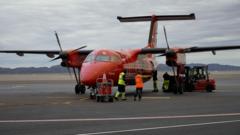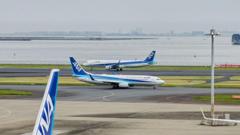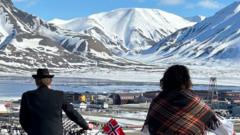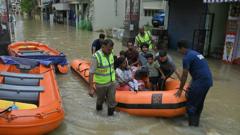Greenland's capital, Nuuk, is set to welcome its first international airport at the end of November, enabling larger aircraft and facilitating direct flights from major cities in the US and Europe. This development is expected to significantly impact the local economy, particularly tourism, while also sparking discussions about environmental and social changes within the community.
Greenland Expands Horizons with New International Airport

Greenland Expands Horizons with New International Airport
The opening of Nuuk's international airport marks a transformative moment for Greenland, promising enhanced accessibility for tourism and trade.
Greenland is on the verge of a significant transformation with the upcoming opening of its first international airport in Nuuk, scheduled for late November. This development will allow larger planes to land directly in the capital, bringing new opportunities for travel and trade. Until now, residents and visitors have been dependent on smaller aircraft that require travelers to connect through a former military base in Kangerlussuaq, situated 200 miles north of Nuuk.
The new airport will feature a longer runway and a modern terminal, allowing direct flights to Copenhagen and, next summer, New York City via United Airlines. This expansion is part of a broader initiative to make the Arctic territory more accessible, foster tourism, and stimulate the local economy, which heavily relies on public spending and fishing.
Nuuk, a small town of approximately 18,000 residents, is gearing up for the influx of tourists that experts predict will follow the airport's inauguration. Chief Executive of Greenland Airports, Jens Lauridsen, expressed optimism about the potential increase in tourism, stating it would "be a big impact." Current infrastructure limitations have imposed long travel times and inconveniences, but the new airport aims to alleviate these issues.
Concerns about environmental impact and costs have been voiced, yet many locals, like young resident Isak Finn, welcome the change for decreasing travel delays associated with connections. The $800 million projects, funded partly by loans from Denmark following interest from Chinese investors, are seen as a means to revitalize and diversify Greenland's economy. The region is anticipated to draw interest from major European carriers, leveraging its geographical position as a hub between North America and Europe.
While the potential for increased tourism is a point of excitement, there are apprehensions regarding rapid development. Tourism Minister Naaja Nathanielsen mentioned the need to spread visitors across different areas to avoid overwhelming smaller communities, drawing lessons from other nations that have faced similar challenges.
Greenlandic businesses, particularly in hospitality and tourism, are preparing for this new chapter. Inuk Hostel's co-owner, Maren-Louise Paulsen Kristensen, is optimistic yet cautious about the pace of development, emphasizing the necessity for sustainable approaches to growth.
As the year progresses, Nuuk is expected to embrace its new role as a travel hub, potentially leading to a "profound" impact on Greenlandic society overall. The evolution brought by the new airports promises a mixed outlook of opportunity, growth, and careful transition for this unique Arctic territory.



















